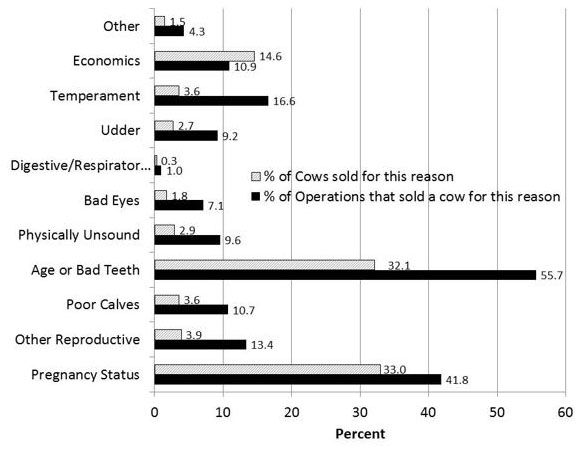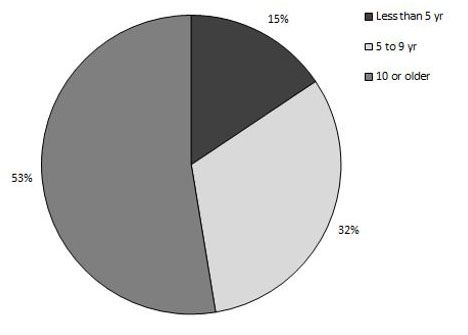Introduction
Culling decisions are important to maintain the productivity and profitability of the beef cow herd. Culling of cows from the herd eliminates poorly performing cows, inferior genetics, and cows with quality defects that would limit short- and long-term productivity. There are numerous reasons to cull a cow from the herd that are discussed below. Cow culling and replacement are ongoing processes and integral parts of cow herd management.
Reasons to Cull
The primary productive objective of any cow in the herd is to produce a live calf on an annual basis. Therefore, any cow that does not get pregnant or wean a calf should be a primary candidate for culling from the cow herd. Annual production of a calf provides revenue to offset yearly expenses related to cow maintenance, heifer development, and initial cow purchase, and ultimately increases profits for the beef cattle enterprise. Signs of reproductive failure can be cow culling triggers. Other culling decisions are made based on additional undesirable cow characteristics or financial and environmental reasons.
Figure 1 displays the spectrum of reasons that beef cattle operations gave for selling or culling a cow from the herd (USDA 2008). Approximately 41% of beef cattle operations reported that they culled a cow for non-pregnant status, which is the primary determinant of beef cow profitability. Fifty-five percent of beef cattle operations culled a cow due to age or bad teeth, which is an issue that can lead to long-term concerns regarding cow nutrition, body condition score, and reproductive success. The combined reasons of reproduction and cow age dominated the culling decision for any beef cattle enterprise. Cow temperament (16%) and other unspecified reproductive issues (13%) were the second most frequently cited reasons that a beef operation culled cows. Economic reasons (10.9%) for culling cows included the negative effect of drought on enterprise stocking capacity, need for additional income, and planned herd reduction. The remaining reasons cited for cow culling (in descending order) were related to physical issues, such as poorly performing calves, physically unsound cows, udder issues, poor eyes, and disease (USDA 2008).

Credit: USDA (2008).
Physical and quality defects of cull cows are more fully described in a series of documents titled Cull Cow Beef Quality Issues (AN307, AN308, AN309, AN310, AN311, AN312).
The age of cull cows is an important consideration. Cow age at culling is reflective of the overall cow longevity within the herd and the opportunity to recoup development costs. Cows that are culled at a young age have not produced enough calves to recover development costs or reached peak calf weaning weight to evaluate genetic quality. Cows culled at a young age reflect a potentially poor match of cow genetics to the production environment, primarily because cow nutrient requirements are not met by the nutritional resources. Figure 2 depicts the percentage of cows culled for any reason based on age. Cows under 5 years of age constituted 15% of the cows reported culled. Generally, cows that are culled within this age range are culled for reproductive reasons, since they have not experienced the physical issues that plague older cows. Cows between 5 and 9 years of age made up 32% of the culled cows. Cows in this age range are certainly culled for reproductive reasons, but may also have physical issues that are beginning to limit production. Aged cows over 10 years of age made up the majority of cows culled at 53%. Aged cows may be culled for all reasons, including reproduction and physical issues that hinder production (USDA 2008).

Credit: USDA (2008).
Most cows are culled for failure to become pregnant, followed by age-related issues. Culling animals that do not generate revenue is imperative. One consideration is the cost of replacement compared to the annual maintenance cost of a non-producing cow. With the increasing cost of replacement heifers, the maintenance of a cow that misses at producing a calf once may merit consideration.
Replacement of Culled Cows
Cow culling necessitates replacement of those animals in order to maintain the herd population. Replacements can potentially be found among the heifer calves born from the cow herd. The costs and benefits of developing replacement heifers are addressed in the EDIS documents entitled What Does It Cost to Develop a Replacement Heifer? (http://www.edis.ifas.ufl.edu/an238) and Improving the Productivity of Beef Heifers in Florida (http://www.edis.ifas.ufl.edu/an132). Assuming that heifers are retained from the cow herd, the number of replacement females needs to be determined. The number of heifer calves that must be kept varies from herd to herd and depends on a number of factors. The primary factors that determine the number of heifers needed as replacements include the reproductive rate in the herd, future herd size plans, age and status of the cows in the herd, and the cow herd culling rate. Cow herd dynamics such as age, death, infertility, and productivity result in a culling rate of 15 to 20% in any year. The percent of heifers to retain for replacement can be determined by knowing the culling rate and the weaned calf crop (Table 1). Low cow herd culling rates allow cow herd managers to be more selective in choosing from the heifer calves available. However, greater cow herd culling rates or lower calf crop weaning percentages result in a greater percentage of heifers that must be retained as replacements.
The heifer selection and development program is not a one-time evaluation and selection process. Post-weaning growth and reproductive performance of developing heifers must be considered while determining the percentage or number of heifers that need to be retained. Table 2 provides estimations of the heifer needs to replace cull cows when the outcomes of heifer growth and reproduction are considered (Southern Regional Handbook 1977). The percentage of heifer calves retained must exceed the actual need, because not all retained heifers will meet growth goals or become pregnant. According to Table 2, if 30% of the heifer calf crop is needed to meet the culled cow vacancy, and 25% of the retained heifers are culled after weaning because they did not adequately grow or become pregnant, then 40% of the total heifers from the calf crop will need to be retained at weaning to meet the replacement demand. The retained heifers that manage to make it through development and become pregnant represent an improvement in cow herd genetics and should be adapted to the management environment of the beef cattle enterprise.
Replacements for culled cows present an opportunity to improve the genetic characteristics of the cow herd. However, because heifers should be sequentially evaluated and selected at weaning and after the development-breeding period, more heifers will have to be retained at weaning to meet replacement demand. The cow culling rate and the economic considerations associated with heifer development are key factors to keep in mind while planning the retention of heifers.
Summary
Culling cows is a management practice that should be routinely employed to remove cows that fail to wean a calf on an annual basis or develop physical issues that inhibit performance, and to meet the resource availability of the beef cattle enterprise. Culling cows from the cow herd creates vacancies to be filled to ensure the long-term herd size and revenue potential of the operation. The combination of cow culling rate and heifer calf crop determines the number of required cows and available replacements.
References
Hersom, M., T. Thrift, and J. Yelich. 2013. What Does It Cost to Develop a Replacement Heifer? AN238. Gainesville: University of Florida Institute of Food and Agricultural Sciences. https://ufdc.ufl.edu/IR00008171/00001
Humes, P. E., and J. S. Sullivan, Jr. 1977. Southern Regional Beef Cow-Calf Handbook. "Selection and Culling of Females." SR1004. Gainesville: Cooperative Extension Service, IFAS, University of Florida. https://ufdc.ufl.edu/UF00095014/00001/24x
Imler, A., M. Hersom, T. Thrift, J. Yelich, and M. Irsik. 2014. Cull Cow Beef Quality Issue: Injection Sites and Abscesses. AN308. Gainesville: University of Florida Institute of Food and Agricultural Sciences. https://doi.org/10.32473/edis-an308-2014
Imler, A., M. Hersom, T. Thrift, J. Yelich, and M. Irsik. 2014. Cull Cow Beef Quality Issue: Horns, Ocular Squamous Cell Carcinoma, and Lumpy Jaw. AN309. Gainesville: University of Florida Institute of Food and Agricultural Sciences. https://doi.org/10.32473/edis-an309-2014
Imler, A., M. Hersom, T. Thrift, J. Yelich, and M. Irsik. 2014. Cull Cow Beef Quality Issue: Bruising, Condemnation and Foreign Objects. AN310. Gainesville: University of Florida Institute of Food and Agricultural Sciences. https://doi.org/10.32473/edis-an310-2014
Imler, A., M. Hersom, T. Thrift, J. Yelich, and M. Irsik. 2014. Cull Cow Beef Quality Issue: Hide Defects, Contamination, and Non-Ambulatory Cattle. AN311. Gainesville: University of Florida Institute of Food and Agricultural Sciences. https://doi.org/10.32473/edis-an311-2014
Imler, A., M. Hersom, T. Thrift, J. Yelich, and M. Irsik. 2014. Cull Cow Beef Quality Issue: Cow Condition and Muscling. AN312. Gainesville: University of Florida Institute of Food and Agricultural Sciences. https://doi.org/10.32473/edis-an312-2014
Imler, A., M. Hersom, T. Thrift, J. Yelich, and M. Irsik. 2014. Overview of Cull Cow Beef Quality. AN307. Gainesville: University of Florida Institute of Food and Agricultural Sciences. https://doi.org/10.32473/edis-an307-2014
Lancaster, P., C. Prevatt, and J. Arthington. 2015. Improving the Productivity of Beef Heifers in Florida. AN132. Gainesville: University of Florida Institute of Food and Agricultural Sciences. https://doi.org/10.32473/edis-an132-2015
USDA. 2008. "Beef 2007–08 Part IV: Reference of beef cow-calf management practices in the United States, 2007–08." Accessed June 5, 2015. https://www.aphis.usda.gov/animal_health/nahms/beefcowcalf/downloads/beef0708/Beef0708_dr_PartIV_1.pdf.
Tables
Percentage of heifer calves to be retained based on reproductive and culling rates in the cow herd1